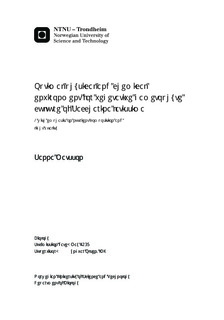Optimal physical and chemical environment for vegetative gametophyte culture of Saccharina latissima: - with emphasis on nutrient composition and light quality
Master thesis
Permanent lenke
http://hdl.handle.net/11250/245250Utgivelsesdato
2013Metadata
Vis full innførselSamlinger
- Institutt for biologi [2596]
Sammendrag
The production of sporelings is a bottle-neck when cultivating Saccharina latissima. Establishing a vegetative gametophyte stocks gives a constant supply of healthy sporelings, enabling a year-round cultivation independent of the availability of natural spores. Finding optimal conditions for vegetative growth of gametophytes are of importance to produce mass quantities of sporelings. In the present study, it was desirable to establish optimal fysical and chemical environments for vegetative gametophyte culture of S. latissima which can be used in large scale cultivation systems. This were examined by five different experiments evaluating the effect of nutrient composition and light quality on growth and development on S. latissima gametophytes. The two most commonly used media when cultivating laminaria; Provasoli s Enriched seawater (PES) and Guillard s f/2 medium (f/2), were examined. The nutrient compisiton were examined through the addition of nitrogen (N) and phosphorous (P) in different concentrations and ratios to steralized seawater (SSW). The growth hormones kinetin (KIN) and Indole-3-acetic acid (IAA) was added in different concentrations to PES in a concentration gradient and the seaweed extract AlgeaFert was added in different concentrations to half strength PES (PES/2) due to its assumed presence of several plant growth substances. The growth of gametophytes was compared under red LED lights preventing fertility and under white florescence lights. White light contains blue wavelengths, thereby inducing fertility. Altering the nutrient ratio can be used to manipulate gametophyte cultures to grow vegetatively. The experiments conducted in white light therefore had a gradient of N:P ratios to evaluate the effect on fertility. The experiments revealed the growth of S. latissima gametophytes to be highly dependent on the chemical composition of the medium it was grown in and it had a significantly higher growth in PES compared to f/2. An increased growth was strongly affected by the presence of chelating agents, an increased concentration of N and P and a low ratio between them, and the addition of a low concentration of seaweed extract. The present study demonstrated that an alternation of light quality from red LED light to warm-white fluorescence light gave a significantly increased growth of S. latissima gametophytes. Since none of the treatments in this study resulted in fertility it cannot be concluded which treatments that inhibit fertilization and promote vegetative growth.
